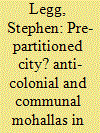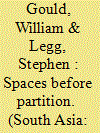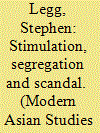|
|
|
Sort Order |
|
|
|
Items / Page
|
|
|
|
|
|
|
| Srl | Item |
| 1 |
ID:
164048


|
|
|
|
|
| Summary/Abstract |
This paper explores the mohallas of Delhi, sub-communities within the city, and asks whether Delhi was pre-partitioning before August 1947. It suggests that the mohalla was a site of political mobilisation that was systematically used by the Congress from the Civil Disobedience movement of 1930 onwards. During the early 1940s, communal voluntary associations like the Muslim League’s National Guard and the Rashtriya Swayamsevak Sangh attempted to establish representatives and training practices within mohallas. The paper concludes that the mohalla provided a space and a scale at which to view communal violence afresh, as one of the many ‘spaces before Partition’ that were reshaping (in) the 1940s.
|
|
|
|
|
|
|
|
|
|
|
|
|
|
|
|
| 2 |
ID:
164042


|
|
|
|
|
| Summary/Abstract |
This introduction frames a selection of papers that encourage a richer spatial understanding of the years before the Partition of India. The papers respond to two types of questions. One type is spatial (at what scale do we approach Partition? Through which spaces should we attempt to understand both micro and macro processes? Movements across what distances constituted Partition?). The second type is temporal (what timescales do we invoke when approaching Partition? Of what was it the endpoint? What sort of memories were invoked and made during India’s multiple partitions?). This introduction establishes the main trends in Partition historiography, tracked through the last two decennial anniversaries. It sketches out spatial analyses of Partition to date, regarding territory and displacement especially, but shows that much of this geographical interpretation has been implicit rather than explicit, and that most have begun with Partition. Whilst framing many of their arguments in twentieth-century colonial practice, and occasionally straying into the post-colonial, the papers in this special issue mostly focus on the 1930s–1940s at a range of scales (from the international, through the nation-state, to cities, mohallas and courtrooms). Collectively they make the argument that if Partition has a history, then it also has an historical geography. We hope these papers will help people read these histories and geographies with a finer spatial eye.
|
|
|
|
|
|
|
|
|
|
|
|
|
|
|
|
| 3 |
ID:
115284


|
|
|
|
|
| Publication |
2012.
|
| Summary/Abstract |
This paper explores the regulation of prostitution in colonial India between the abolition of the Indian Contagious Diseases Act in 1888 and the passing of the first Suppression of Immoral Traffic Act in 1923. It challenges the commonly held assumption that prostitutes naturally segregated themselves in Indian cities, and shows that this was a policy advocated by the Government of India. The object was to prevent the military visiting these segregated areas, in the absence of effective Cantonment Regulations for registering, inspecting, and treating prostitutes. The central government stimulated provincial segregation through expressing its desires via demi-official memoranda and confidential correspondence, to which Rangoon and Bombay responded most willingly. The second half of the paper explores the conditions, in both India and Ceylon, that made these segregated areas into scandalous sites in the early twentieth century. It situates the brothel amongst changing beliefs that they: increased rather than decreased incidents of homosexuality; stimulated trafficking in women and children; and encouraged the spread of scandalous white prostitutes 'up-country', beyond their tolerated location in coastal cosmopolitan ports. Taken alongside demands that the state support social reform in the early twentieth century, segregation provided the tipping point for the shift towards suppression from 1917 onwards. It also illustrates the scalar shifts in which central-local relations, and relations between provinces, in government were being negotiated in advance of the dyarchy system formalized in 1919.
|
|
|
|
|
|
|
|
|
|
|
|
|
|
|
|
|
|
|
|
|